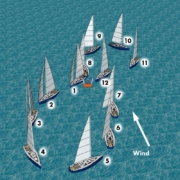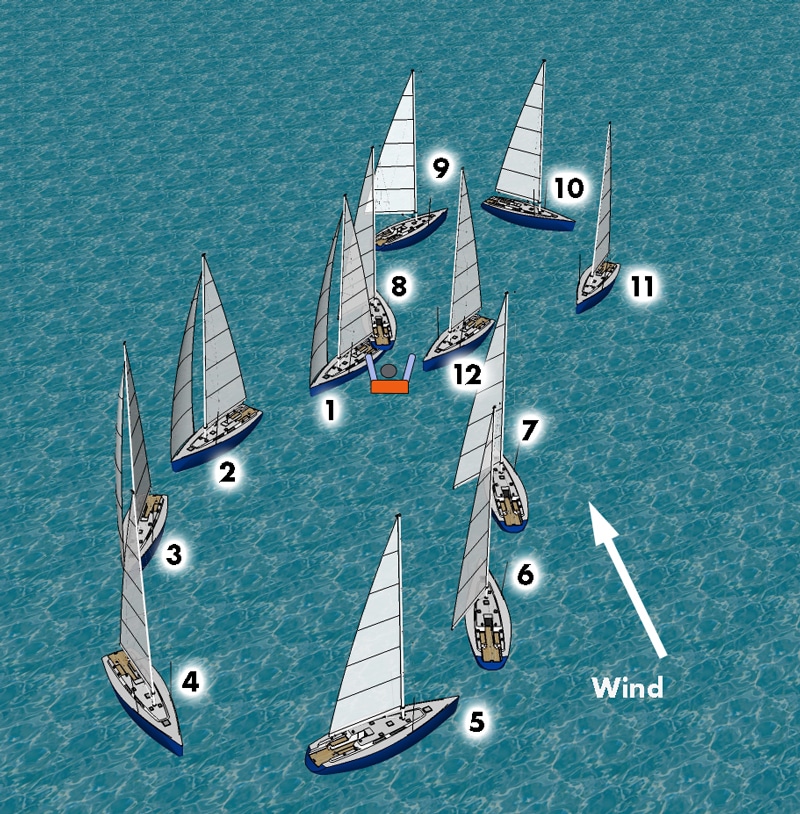Crew Overboard
Crew (“Man”) Overboard (MOB) is fortunately relatively rare, but chances are that in your sailing career, it will happen. MOB means that someone has fallen off the vessel and (hopefully) is bobbing in the water as the vessel sails away. It can be life-threatening. MOB is a high-stress event, especially for the person in the water, and often the crew will panic. Even at five knots the distance between the MOB and the vessel increases rapidly. And given waves, it is very easy to lose sight of the person. Distance plus the coldness of the water increases the chance that you might not be able to recover the person alive. MOB is serious.
Every skipper must have a plan and practice for this eventuality. On every outing, the skipper should brief the crew on following the skipper’s command and remain calm in that eventuality. Next time you’re out, simply throw a PFD overboard and try to recover it. You’ll find that recovery is not that easy. Skippers should train spouses or regular boat buddies on the procedure to recover themselves should the skipper fall overboard.
While MOB can occur in many scenarios, it is commonly the result of someone slipping on a wet deck, equipment failure, or just not paying attention as the vessel lurches. Fast and rehearsed action is essential and can avert a real tragedy.
MOB Is Aptly NamedSailing 10 miles out off Corsica, the crew sitting on the foredeck heard a small splash sound. They turned around to see that David, the helmsman, was not at the helm anymore. Fortunately for David, they decided to investigate. They discovered him floating and waving his arms frantically 100 meters behind the boat. David had made a near-fatal mistake of setting autopilot and taking a whiz off the back of the boat without telling anyone and without the aid of a jack-line. MOB is called Man Over Board because of this exact reason. Men taking whizzes off the back. |
The key to increasing the chances of recovering your friend/family member alive is practice-practice-practice. Why would you not? There is a reason emergency services conduct safety drills. And besides, practicing is actually fun.
The first order is to appoint a crew member to keep a watch on the MOB at all times. You must say these words to the appointed watch crew member:
“No matter what happens on the boat, no matter what else is happening, no matter what anyone says, DO NOT take your eyes off the MOB even for an instant. If you do, we could lose him.”
Next, you must deploy to the MOB some temporary flotation as well as a flag marker if available. Next, get a position fix. (Most GPS systems have a MOB button. Activate it immediately.) Now you must initiate a plan for recovery.
It is also vital that you gain control and the attention of the remaining crew. Use the names of people when issuing orders and make the orders specific. For example, instead of “Someone get a throw line,” say “John, in the port aft lazarette, there is a long white throw line. Get it out now, please.”
If a child is involved and you determine it is prudent for someone to jump in, be certain that individual (often a parent) has adequate flotation to prevent a second major problem. However, concentrate on getting the boat back to the MOB position first as fast as possible.
There are many suggested strategies for recovering an MOB. Every helmsperson, vessel owner, and/or person in charge should have practiced various procedures that they can become confident with.
The biggest thing to remember as the captain and leader of the crew is to keep your crew calm. Give complete and non-confusing orders and remain calm. Your crew will pick up on your confidence and follow you if they see you’re in control.
Methods of Recovery
It is your call as the skipper of the vessel as to which recovery method you feel is the safest based on the conditions and your experience.
The Heave-To Method
Heave-to is a very effective MOB recovery method and should be considered as a first option, especially if the victim can easily swim back to the boat. Review the heave-to discussion Chapter 7: Sailing. When you heave to, the boat almost instantly stops dead in the water. The faster it is done, the less distance the boat gets away from the victim, and often the victim is able to swim back to the boat. It requires little or no effort by the crew because the jib is left alone and only the main is let out after the boat is tacked.
MOB Recovery with Power
MOB recovery can be safely done using engine power. Many circumstances—cold water, high waves, or your lack of confidence in your sailing skills—may make it more prudent to use your engine to get back to your MOB as fast as possible. Even with small waves, a person can be lost in only a few boat lengths.
When the decision is to motor to the MOB, several precautions should be taken.
- Ensure no lines are over the side before starting the engine.
- Be especially careful of speed in approaching the MOB. Maintain steerage.
- Be aware of the propeller when close to the MOB.
MOB Recovery Under Sail
The following is a diagram showing a MOB recovery starting from a close-haul point of sail where the MOB situation occurs.
MOB
- MOB happens: Immediately announce “Man Overboard.” Appoint a dedicated watchperson. Get a life ring and anything else that floats overboard. Hit the MOB button on your GPS. Gain control of crew.
- Ensure no lines are overboard. Start the engine. Head into the wind and begin a crash tack.
- Tighten up the main sheet. Maintain control of the crew. Act decisively with your crew. It is imperative that you lead the crew.
- Furl or drop the headsail.
- Head back downwind toward your MOB.
- Get throw lines ready and cleated to the boat.
- Communicate to the remaining crew the plan.
- Drive the boat to a downwind position.
- Bring the boat around.
- Ensure the boat and your crew are ready for pickup.
- Head toward your MOB from downwind.
- Bring the boat alongside the MOB. If you don’t have a rear transom on your boat you’ll need a block and tackle, a spare halyard, or the boom topping lift to get your MOB on board. Be aware that pulling a person out of the water is virtually impossible. Your boat is equipped with all types of winches, blocks, and halyards—use them. Next time you’re on your boat, plan what you would do to get a heavy person back into your boat. Buy equipment if necessary.
The Deep-Beam-Reach Method
The deep beam reach shown in the below video is also useful for an MOB recovery when the course has been anywhere from upwind to a broad reach. It involves sailing a broad reach to a position slightly away from the MOB, then tacking, then bearing downwind a little so as to make the approach on a close reach. The issue with the deep beam method is that it requires more space to make the maneuver, taking you further away from the MOB. In waves, this is not desirable as the crew may lose sight of the MOB.
MOB Deep Beam Reach
A close reach is a good point of sail to approach a MOB under sail because you can easily depower or repower the mainsail to control the final approach and stop.
- MOB announcement, flotation deployment, crew assignments.
- Bear away to a broad reach.
- Trim the mainsail, furl, or drop jib if sufficient crew.
- Tack around.
- Sail back toward the MOB such that the final approach will be on a close reach.
- Prior to reaching the victim, depower the mainsail by letting it out and then turn upwind on to a close-reach angle. Allow the boat’s momentum to carry the boat to a point slightly windward of the victim and stop next to the victim. Be aware that the boat’s momentum does not carry you past the victim. If you stop short, that’s okay; you can power the mainsail slightly by bringing it in.
Positioning the boat windward of the MOB is generally the best because the windage will push the boat toward the MOB. In high waves, there are complications of the boat being lifted on top of the MOB. In this situation, you may consider leeward. However, you may find the boat being pushed away too fast. This is why you will find it easier to use the engine to gain closer control of the boat and MOB positions in most circumstances.
The Quick Stop Method
This is the fastest means for returning to a victim, always keeping the boat relatively close by. It is basically a tack followed by a big circle back to the MOB. View this video:
Quick-Stop Method
- MOB announcement, flotation deployment, crew assignments.
- Immediately tack the boat.
- Begin the turn downwind; ignore jib if the crew is not available to tend.
- Continue turning directly downwind. Ease out the mainsheet.
- Sail downwind for only a boat length or two, trimming sails if possible, but not necessarily. Drop the jib if possible.
- Control the mainsheet to prepare for gybing.
- Gybe the boat.
- Sail upwind to windward of the victim. Try to angle the boat to be on a close reach at the stopping point. Luff or drop all sails.
More MOB Thoughts
- Ensure no lines are over the side before starting the engine.
- Be especially careful of the boat’s momentum in approaching the MOB. Maintain steerage. Be aware of the propeller when close to MOB.
- Always during sailing have lines and throwable flotation available within quick reach.
- Consider specialized MOB hoisting gear when your boat does not have an easy entry transom.
- Stow a change of clothes and a blanket on your boat.
Final note comparing power versus sail recovery: It is your decision on how to get back to the crew member as fast as possible depending on conditions and your ability. Some instructors teach only the sail-back method because they are concerned with lines in the water getting caught in the prop. Some teach to start the engine and motor back while dousing the sails because it does not rely on your expert sailing ability to get back to your crew member in the exact precise position. Some say the heave-to method is the way to go. It is a contentious point among instructors. We leave it up to you as the skipper who knows your own abilities the best. If you are not confident about sailing back then don’t (check for lines in the water before you start your engine). If you can do a heave-to or a crash tack or some other method and sail back with confidence then do that. The key is to practice in all conditions. Train hard—fight easy!
The next time you’re heading out, take this book and practice the methods discussed. You’re the skipper. Become an expert at being able to save a life when called upon in an MOB situation. Note that you will be called upon at some time in the future.








